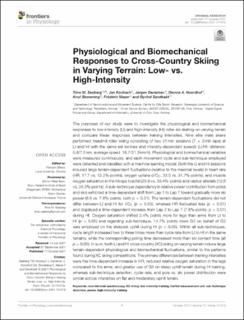| dc.contributor.author | Seeberg, Trine Margrethe | |
| dc.contributor.author | Kocbach, Jan | |
| dc.contributor.author | Danielsen, Jørgen | |
| dc.contributor.author | Noordhof, Dionne | |
| dc.contributor.author | Skovereng, Knut | |
| dc.contributor.author | Meyer, Frederic | |
| dc.contributor.author | Sandbakk, Øyvind Bucher | |
| dc.date.accessioned | 2022-05-31T12:35:21Z | |
| dc.date.available | 2022-05-31T12:35:21Z | |
| dc.date.created | 2021-11-10T17:44:29Z | |
| dc.date.issued | 2021 | |
| dc.identifier.citation | Frontiers in Physiology. 2021, 12, 741573. | en_US |
| dc.identifier.issn | 1664-042X | |
| dc.identifier.uri | https://hdl.handle.net/11250/2997062 | |
| dc.description.abstract | The purposes of our study were to investigate the physiological and biomechanical responses to low-intensity (LI) and high-intensity (HI) roller ski skating on varying terrain and compare these responses between training intensities. Nine elite male skiers performed treadmill roller skiing consisting of two 21 min sessions (7 × 3 min laps) at LI and HI with the same set inclines and intensity-dependent speeds (LI/HI: distance: 5.8/7.5 km, average speed: 16.7/21.3 km/h). Physiological and biomechanical variables were measured continuously, and each movement cycle and sub-technique employed were detected and classified with a machine learning model. Both the LI and HI sessions induced large terrain-dependent fluctuations (relative to the maximal levels) in heart rate (HR, 17.7 vs. 12.2%-points), oxygen uptake (V.O2, 33.0 vs. 31.7%-points), and muscle oxygen saturation in the triceps brachii (23.9 vs. 33.4%-points) and vastus lateralis (12.6 vs. 24.3%-points). A sub-technique dependency in relative power contribution from poles and skis exhibited a time-dependent shift from Lap 1 to Lap 7 toward gradually more ski power (6.6 vs. 7.8%-points, both p < 0.01). The terrain-dependent fluctuations did not differ between LI and HI for V.O2 (p = 0.50), whereas HR fluctuated less (p < 0.01) and displayed a time-dependent increase from Lap 2 to Lap 7 (7.8%-points, p > 0.01) during HI. Oxygen saturation shifted 2.4% points more for legs than arms from LI to HI (p > 0.05) and regarding sub-technique, 14.7% points more G3 on behalf of G2 was employed on the steepest uphill during HI (p < 0.05). Within all sub-techniques, cycle length increased two to three times more than cycle rate from LI to HI in the same terrains, while the corresponding poling time decreased more than ski contact time (all p > 0.05). In sum, both LI and HI cross-country (XC) skiing on varying terrain induce large terrain-dependent physiological and biomechanical fluctuations, similar to the patterns found during XC skiing competitions. The primary differences between training intensities were the time-dependent increase in HR, reduced relative oxygen saturation in the legs compared to the arms, and greater use of G3 on steep uphill terrain during HI training, whereas sub-technique selection, cycle rate, and pole vs. ski power distribution were similar across intensities on flat and moderately uphill terrain. | en_US |
| dc.language.iso | eng | en_US |
| dc.publisher | Frontiers | en_US |
| dc.rights | Navngivelse 4.0 Internasjonal | * |
| dc.rights.uri | http://creativecommons.org/licenses/by/4.0/deed.no | * |
| dc.subject | Near-infrared spectroscopy | en_US |
| dc.subject | XC skiing | en_US |
| dc.subject | Low-intensity training | en_US |
| dc.subject | Inertial measurement unit | en_US |
| dc.subject | Sub-technique detection | en_US |
| dc.subject | Power | en_US |
| dc.subject | High-intensity training | en_US |
| dc.title | Physiological and Biomechanical Responses to Cross-Country Skiing in Varying Terrain: Low- vs. High-Intensity | en_US |
| dc.type | Peer reviewed | en_US |
| dc.type | Journal article | en_US |
| dc.description.version | publishedVersion | en_US |
| dc.rights.holder | © 2021 Seeberg, Kocbach, Danielsen, Noordhof, Skovereng, Meyer and Sandbakk | en_US |
| dc.source.pagenumber | 15 | en_US |
| dc.source.volume | 12 | en_US |
| dc.source.journal | Frontiers in Physiology | en_US |
| dc.identifier.doi | 10.3389/fphys.2021.741573 | |
| dc.identifier.cristin | 1953374 | |
| dc.relation.project | Norges forskningsråd: 270791 | en_US |
| dc.source.articlenumber | 741573 | en_US |
| cristin.ispublished | true | |
| cristin.fulltext | original | |
| cristin.fulltext | original | |
| cristin.qualitycode | 1 | |

